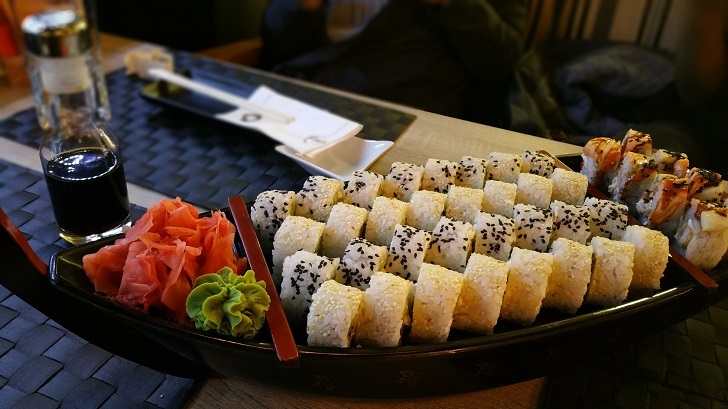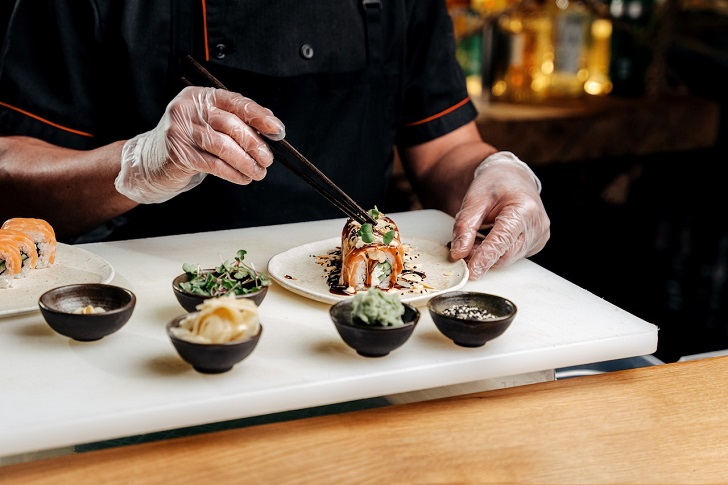Sushi, a Japanese culinary treasure, has captured people’s hearts (and taste buds) worldwide. It has evolved from an exotic delicacy to a beloved everyday food in the United States. But it might be time to rethink your approach if you’ve been devouring your sushi rolls without a second thought.
To help you savor this Japanese delight to the fullest, we’ve enlisted the expertise of three sushi and Japanese food lovers. Get ready to discover the secrets of eating sushi the right way.
The Casual Approach to Sushi Eating
First things first, dispel any notions of rigid sushi-eating rituals. According to Chef Masatomo “Masa” Hamaya of O-Ku, there’s no need for solemn reverence. Sushi originally started as a finger food in Japan, so it’s perfectly acceptable to ditch the chopsticks and use your hands, especially when devouring sashimi.
However, this doesn’t mean it’s a sushi free-for-all. When faced with an array of sushi options, start with a strategy. In “The Complete Guide to Sushi & Sashimi,” Jeffrey Elliot and Robby Cook recommend beginning with lighter fish, such as whitefish, before progressing to richer, oilier varieties. Japanese culture values order and balance, even in sushi selection.

SM-N910F/ Pxhere | Sushi is a very versatile dish and can be made with various ingredients
The Pre-Sushi Ritual
There are essential steps to follow before you indulge in your sushi feast. Here’s your pre-sushi ritual:
Clean Your Hands
Upon seating, you’ll receive a warm or cold damp towel for hand cleaning. This gesture, known as omotenashi, symbolizes Japanese hospitality. In the past, diners would wipe their hands on noren, traditional Japanese curtains, and a dirtied noren signified a popular, high-quality restaurant.
Fold the Towel
After using the towel, fold it neatly and place it on the provided tray; don’t create a messy pile. In the United States, servers might clear it away for you.
Chopstick Etiquette
If your sushi joint provides disposable chopsticks (waribashi), split them apart from the packaging. However, avoid the common mistake of rubbing them together, as it suggests low-quality chopsticks. Keep an eye out for a chopstick holder; using it is a sign of respect in high-end sushi establishments.

Ivan Samkov/ Pexels | Sushi has evolved from an exotic delicacy to a beloved everyday food in the United States
Sauce Preparation
Pour soy sauce into your dipping dish, but never mix it with wasabi. Combining the two creates a wasabi mud that overpowers the sushi’s delicate flavors.
The Sashimi Course
Traditionally, sashimi is served before nigiri and sushi rolls. Noodle or rice dishes, including sushi, usually come later in the meal as “fillers.” Remember, sushi is meant to be savored in one bite, so no nibbling!
Savoring Each Bite
Regarding eating sushi, our experts unanimously agree that one-bite consumption is the way to go. Sushi was designed as finger food; cutting it into smaller pieces is a no-no. Leave the nibbling for another meal.
Soy Sauce and Wasabi Wisdom
Not all sushi needs a dip in soy sauce. It might even be considered impolite to do so immediately, akin to salting a dish before tasting it. Trust the chef’s expertise; they’ve already brushed the sushi with the right soy sauce for your enjoyment.
As for wasabi, most sushi chefs adjust the amount based on the dish’s composition. Don’t assume more is better; it can overwhelm the sushi’s subtleties.

SM-N910F/ Pxhere | Sushi is packed with vitamins and nutrients, so it’s considered a healthy food
Ginger: A Palate Cleanser, Not a Sushi Topper
Resist the urge to place ginger on your sushi; it’s not etiquette. Ginger serves as a palate cleanser between dishes, and chefs will incorporate it into the preparation if needed.
Post-Sushi Cleanup
As you near the end of your sushi adventure, consider these steps:
1. Reset the Sauce Dish (Optional): In formal Japanese dining, a new soy sauce dish may be provided before the sushi course to keep the sauce fresh.
2. Tidy Up Your Space: Keep your food on the plate and avoid making a mess on the table. If you used disposable chopsticks, return them to their packaging and fold it closed.
3. Thank the Chef: If you’re dining at a sushi bar, express your gratitude to the chef. Even if the meal didn’t meet your expectations, acknowledging their efforts shows respect.




